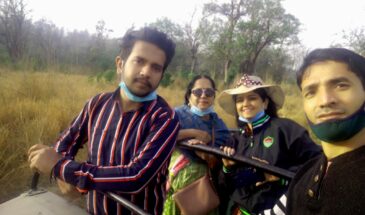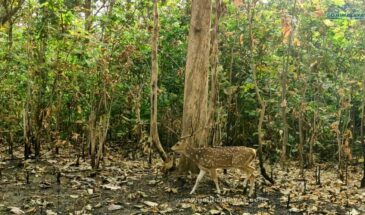- Overview
- Trip Outline
- Trip Includes
- Trip Excludes
- Gallery
- Reviews
- Booking
- FAQ
Safari in Rajaji National Park
Safari in Rajaji National Park is an best opportunity who visiting Uttarakhand for wildlife experience or want enjoy Jungle Jeep Safari. Its well-connected with famous cities like Haridwar, Rishikesh and Dehradun. Rajaji Tiger Reserve is a unique biodiversity reserve in the foothills of the Himalayas . Rajaji National Reserve (Rajaji National Park) was established in the year 1983, by incorporating three wildlife sanctuaries, Chila, Motichur and Rajaji sanctuaries into one unit. The park has been designated as a reserved area for 'Project Elephant' by the Ministry of Environment, Forest and Climate Change, Government of India to strengthen management and conservation activities. In the year 2002, this elephant range was also designated as the 11th elephant reserve in the country, and was designated as the Shivalik Elephant Reserve (c.5405 Km2). The protected area was named Rajaji National Park, named after the late C. Rajagopalachari, the famous freedom fighter and the first Governor-General of independent India, known as Rajaji. It is a spectacular ecosystem that marks the beginning of the Shivalik ranges and the vast Indo-Gangetic plains, which are rich and represent biodiversity. Safari in Rajaji National Park is fomous for watching animals like Asian elephants, cheetahs, bears, cobras, wild boar, bulls, Indian rabbits, wild cats and kakkar are found in this park. Cheetahs, sloth bears, deer and barking deer can also be seen in this park. The Ganges River covers a distance of 24 km in the park. The park has sal, moist forests of the Western Ganges, northern dry deciduous forests and Khair-sheesham forests.
Safari in Rajaji National Park is fomous for watching animals like Asian elephants, cheetahs, bears, cobras, wild boar, bulls, Indian rabbits, wild cats and kakkar are found in this park. Cheetahs, sloth bears, deer and barking deer can also be seen in this park. The Ganges River covers a distance of 24 km in the park. The park has sal, moist forests of the Western Ganges, northern dry deciduous forests and Khair-sheesham forests.
 Safari in Rajaji National Park is open for tourists from 15 November to 15 June every year. Tourists can enjoy the beauty of the hills, the panoramic view of the valleys and rivers during their 34 km long jungle safari.
Safari in Rajaji National Park is open for tourists from 15 November to 15 June every year. Tourists can enjoy the beauty of the hills, the panoramic view of the valleys and rivers during their 34 km long jungle safari.
About The Wildlife
The Rajaji Tiger Reserve is an important reservoir of wildlife and the last shelter for a variety of endangered animal species in the lower Himalayan region and the upper Ganges tract. The presence of a special height holding the plains and the Ganges also strengthens it. The reserve has about 49 species of mammals, over 300 species of birds, about 60 species and 50 species. This protected area is one of the important wildlife habitats in the northwestern Shivalik landscape, which forms the northwestern boundary of the range of tigers, elephants and king cobras in the country. Apart from elephants as the dominant species, the park's major fauna include Panthera tigris (tiger), Panthera pardus (leopard), Ursus thibetanus (Himalayan black bear, Melurus orcinus (dull bear), hyena hyena (hyena)), muntiacus. Muntajak (Barking deer), Nemorhedus goral (linga), Axis axis (spotted deer), Rusa unicolor (sambar) and Sus scrofa (wild boar) are the major ones. Among the reptiles, Crocodylus palace (crocodile) and Ophiophagus hannah (King cobra) represent the fauna diversity of Rajaji. The major flora are Shorea robusta (Sal), Mallotus philippinensis (Kamala), Acacia catechu (Kutch), Haldina cordifolia (Kadam), Terminalia calirica (Behera), Ficus benthalensis (Indian Kelayan) and Dalbergia cisu, (rosewood).
Safari in Rajaji National Park Timing
The park is open for tourists from 15 November to 15 June every year.- 6.30 AM to 6 pm in Rajaji National Park from 15 November to 15 February
- 16 February to 31 March 6 AM to 3 PM
- 1 April to 15 May from 6:30 AM to 7:15 PM
- From 16 May to 15 June, admission can be made from 3.30 AM to 7:15 PM.
Biodiversity profile of Rajaji National Park
| Flora | Fauna (vertebrae) | Fauna (invertebrates) | |||
| Vegetation type | Number of species | Animals | Number of species | Animals | Number of species |
| Trees | 118 | Mammals | 47 | Odonates | 38 |
| Shrubs and herbs | 60 | Reptiles (lizards and snakes) | >20 | Termite | 21 |
| Mountaineer | 33 | Amphibian | 12 | Butterflies | 68 |
| Grass and sed | 48 | Tortoise | 04 | Aesthetic | 14 |
| bamboo | 01 | Fishes | 49 | Scorpion | 5 |
| Parasite | 02 | Bird | 328 | Scolopendrid centipedes | 7 |
Video Link
https://www.youtube.com/watch?v=Acrqm3u_YjoNo details found.
No details found.
No details found.
Please wait...
No Details Found





















There are no reviews yet.